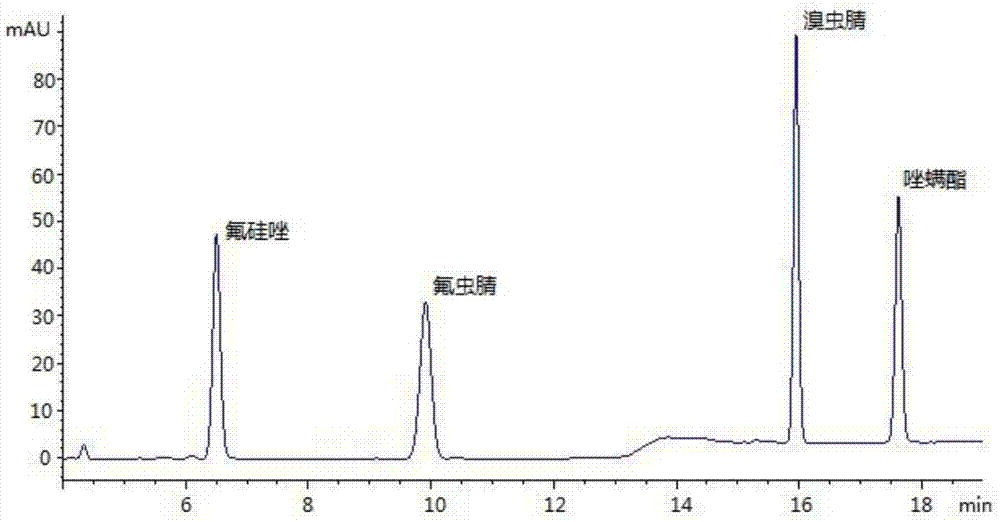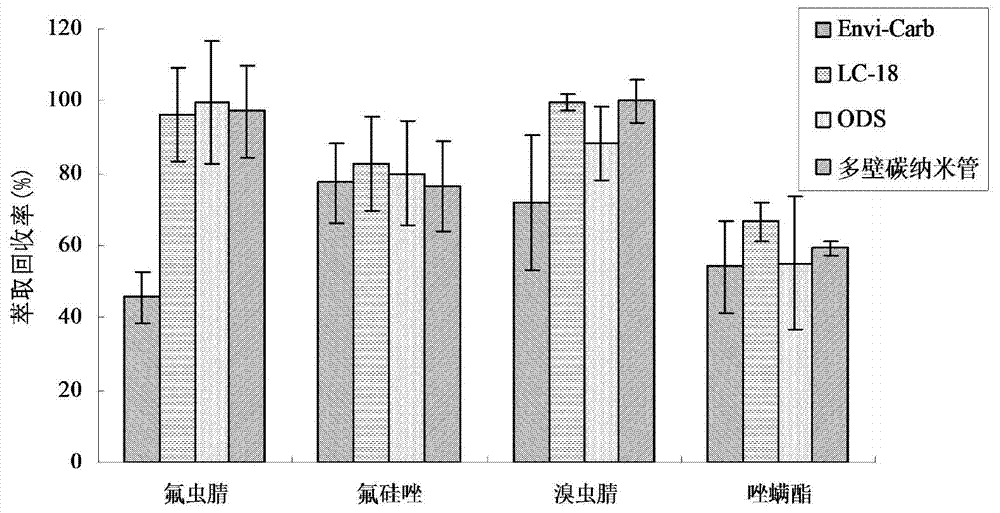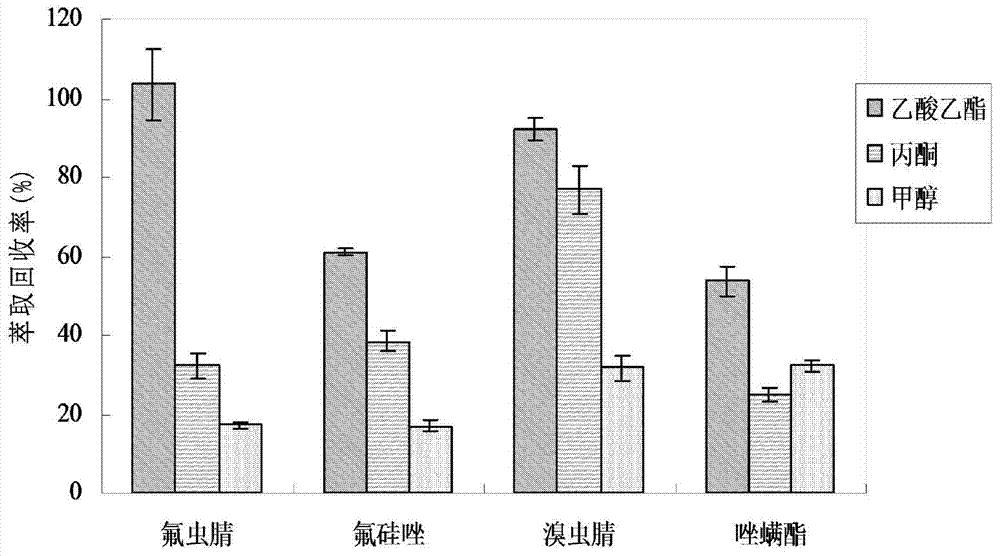Method of detecting flusilazole, fipronil, chlorfenapyr and fenpyroximate in environmental water sample
A determination method and flusilazole technology are applied in the field of detection of pesticide residues in environmental water samples, which can solve the problems of high cost and consumption, single residue can not meet the requirements of rapid and accurate detection, time-consuming and labor-intensive, etc., achieving simple operation and saving detection time. and cost, the effect of accurate analysis results
- Summary
- Abstract
- Description
- Claims
- Application Information
AI Technical Summary
Problems solved by technology
Method used
Image
Examples
specific Embodiment approach
[0030] A method for the determination of flusilazole, fipronil, chlorfenapyr and pyrazafen in environmental water bodies, using solid phase extraction-liquid chromatography for determination, using multi-walled carbon nanotubes as solid phase extraction adsorbents, the obtained The specific steps of the method are as follows:
[0031] (1) Load 150 mg of multi-walled carbon nanotubes into a solid-phase extraction column with a packing height of about 1 cm, and seal both ends with polyethylene porous sieve plates;
[0032] (2) The solid phase extraction column was activated with ethyl acetate, methanol and water respectively;
[0033] (3) 1L water sample with a concentration of 0.2μg / L passes through the solid phase extraction column described in step (1) at a rate of 5mL / min;
[0034] (4) Use 10mL ethyl acetate as the eluent to elute the target substance from the adsorbent;
[0035] (5) The eluent was blown dry with nitrogen gas at room temperature, and the volume was adjuste...
experiment example
[0038] (1) Investigation on extraction recovery rate of different extraction columns
[0039] The selection of solid phase extraction column material is the most important factor affecting the efficiency of solid phase extraction. The present invention compares the use of multi-walled carbon nanotubes and other three kinds of commercial solid phase extraction small columns SupelcleanENVI-Carb, SupelcleanLC-18, Extraction recovery of target compound by Cleanert ODSSPE. The result shows: for 4 kinds of compounds that the present invention analyzes, the extraction recovery rate of multi-walled carbon nanotube column can be compared with commercialized C 18 The extraction recoveries of the columns were comparable, however, the SupelcleanLC-18 was expensive. Moreover, multi-walled carbon nanotubes and C 18 The functional groups and adsorption mechanism of multi-walled carbon nanotubes are different, and the four kinds of compounds of flusilazole, fipronil, chlorfenapyr and pyracl...
Embodiment 2
[0054] Measure four kinds of pyrazoles and pyrrole pesticides (i.e. flusilazole, fipronil, chlorfenapyr and For the residual amount of pyraclofen), the water sample was filtered with a 0.45 μm filter membrane before determination.
[0055] Adopt solid-phase extraction-liquid chromatography to measure, multi-walled carbon nanotubes are used as solid-phase extraction adsorbent, and the concrete steps of described method are as follows:
[0056] (1) Load 150 mg of multi-walled carbon nanotubes into a solid-phase extraction column with a packing height of about 1 cm, and seal both ends with polyethylene porous sieve plates;
[0057] (2) The solid phase extraction column was activated with ethyl acetate, methanol and water respectively;
[0058] (3) 1L water sample with a concentration of 0.2μg / L passes through the solid phase extraction column described in step (1) at a rate of 5mL / min;
[0059] (4) Use 10mL ethyl acetate as the eluent to elute the target substance from the adso...
PUM
| Property | Measurement | Unit |
|---|---|---|
| diameter | aaaaa | aaaaa |
| length | aaaaa | aaaaa |
| size | aaaaa | aaaaa |
Abstract
Description
Claims
Application Information
 Login to View More
Login to View More - R&D
- Intellectual Property
- Life Sciences
- Materials
- Tech Scout
- Unparalleled Data Quality
- Higher Quality Content
- 60% Fewer Hallucinations
Browse by: Latest US Patents, China's latest patents, Technical Efficacy Thesaurus, Application Domain, Technology Topic, Popular Technical Reports.
© 2025 PatSnap. All rights reserved.Legal|Privacy policy|Modern Slavery Act Transparency Statement|Sitemap|About US| Contact US: help@patsnap.com



